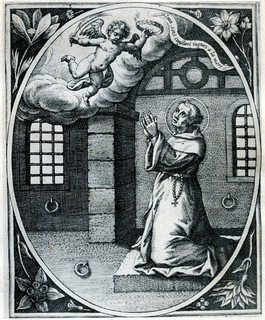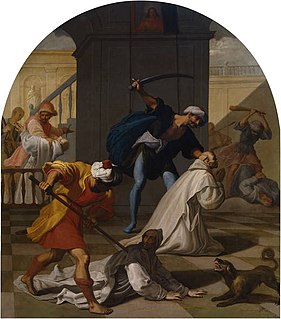Related Research Articles

Hugh Faringdon, earlier known as Hugh Cook, later as Hugh Cook alias Faringdon and Hugh Cook of Faringdon, was a Benedictine monk who presided as the last Abbot of Reading Abbey in the English town of Reading. At the dissolution of the monasteries under King Henry VIII of England, Faringdon was accused of high treason and executed. He was declared a martyr and beatified by the Catholic Church in 1895.
William Gibson was a layman from Ripon in Yorkshire, England, a member of a noble Scottish family, who was executed at York for professing the Roman Catholic faith. He is honoured as a martyr by the Catholic Church.

Richard Reynolds was an English Bridgettine monk executed in London for refusing the Oath of Supremacy to King Henry VIII of England. He was canonised by Pope Paul VI in 1970, among the Forty Martyrs of England and Wales.

The Forty Martyrs of England and Wales or Cuthbert Mayne and Thirty-Nine Companion Martyrs are a group of Catholic, lay and religious, men and women, executed between 1535 and 1679 for treason and related offences under various laws enacted by Parliament during the English Reformation. The individuals listed range from Carthusian monks who in 1535 declined to accept Henry VIII's Act of Supremacy, to seminary priests who were caught up in the alleged Popish Plot against Charles II in 1679. Many were sentenced to death at show trials, or with no trial at all.

John Boste is a saint in the Catholic Church, and one of the Forty Martyrs of England and Wales.

John Stone was an English Augustinian friar who was executed, probably in December 1539; he was canonized in 1970 by Pope Paul VI. He was a doctor of theology from Canterbury.

Irish Catholic Martyrs were 22 Irish men and women who have been beatified or canonized for dying for their Catholic faith between 1537 and 1681 in Ireland. The canonisation of Oliver Plunkett in 1975 brought an awareness of the others who died for the Catholic faith in the 16th and 17th centuries. On 22 September 1992 Pope John Paul II proclaimed a representative group from Ireland as martyrs and beatified them.

Margaret Ward, the "pearl of Tyburn", was an English Catholic martyr who was executed during the reign of Elizabeth I for assisting a priest to escape from prison. She was canonised in 1970, as one of the Forty Martyrs of England and Wales.
This page is an index of lists of people considered martyrs. A martyr is someone who suffers persecution and death for advocating, renouncing, refusing to renounce, or refusing to advocate a belief or cause as demanded by an external party. This refusal to comply with the presented demands results in the punishment or execution of the martyr by the oppressor.
Events from the 1530s in England.

The Eighty-five Martyrs of England and Wales, also known as George Haydock and Eighty-four Companion Martyrs, are a group of men who were executed on charges of treason and related offences in the Kingdom of England between 1584 and 1679. Of the eighty-five, seventy-five were executed under Jesuits, etc. Act 1584.
The Martyrs of the Spanish Civil War are the Catholic Church's term for the people killed by Republicans during the Spanish Civil War for their faith. More than 6,800 clergy and religious were killed in the Red Terror. As of June 2022, 2,095 Spanish martyrs have been beatified; 11 of them being canonized. For some 2,000 additional martyrs, the beatification process is underway.
Saint Arthur of Glastonbury, according to some French sources, was an English Roman Catholic faithful in the sixteenth century. He was martyred during the period of King Henry VIII's suppression of the Catholic Church due to his refusal to accept the king's claim to spiritual leadership of the Church in England.

Blessed Hugh Faringdon is a Catholic state secondary school in Reading in Berkshire, England. The school has approximately 850 pupils on roll and around 100 teaching and non teaching staff. The school specialises in Mathematics and the Performing Arts. Blessed Hugh Faringdon is one of the many Catholic schools in and around Reading but the only secondary and is under the Trusteeship of the Diocese of Portsmouth. The school is a member of the Partners in Excellence group of schools.

The Carthusian martyrs are those members of the Carthusian monastic order who have been persecuted and killed because of their Christian faith and their adherence to the Catholic religion. As an enclosed order the Carthusians do not, on principle, put forward causes for their members, though causes have been promoted by others on their behalf.
During the English Reformation, a number of believers were executed at Lancaster in England as a consequence of their Catholic faith. They are commonly referred to as the Lancaster Martyrs and are commemorated locally by the Lancaster Martyrs Memorial Stone which may be found close to the centre of Lancaster city.
George Douglas was one of the Eighty-five martyrs of England and Wales.

John Eynon was a monk of the Order of Saint Benedict who acted as the pastor of the parish of St Giles in Reading, England. Copies of Robert Aske's proclamation setting forth the reasons behind the Pilgrimage of Grace had circulated at Reading. Eynon was one of those who had made a copy.

One Hundred and Seven Martyrs of England and Wales, also known as Thomas Hemerford and One Hundred and Six Companion Martyrs, are a group of clergy and laypersons who were executed on charges of treason and related offences in the Kingdom of England between 1541 and 1680. They are considered martyrs in the Roman Catholic Church and were beatified on 15 December 1929 by Pope Pius XI.
References
- ↑ Hugh Faringdon and 8 Companions at Hagiography Circle
- ↑ National Calendar for England, Liturgy Office for England and Wales.